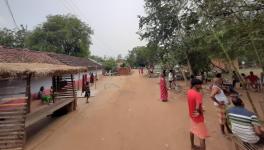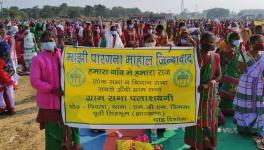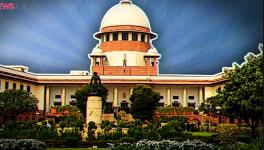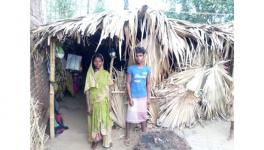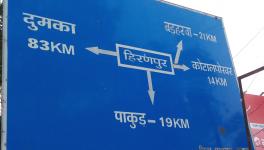Jharkhand: Municipal Expansion Far Away, but Santal Tribals Still Wary of Change
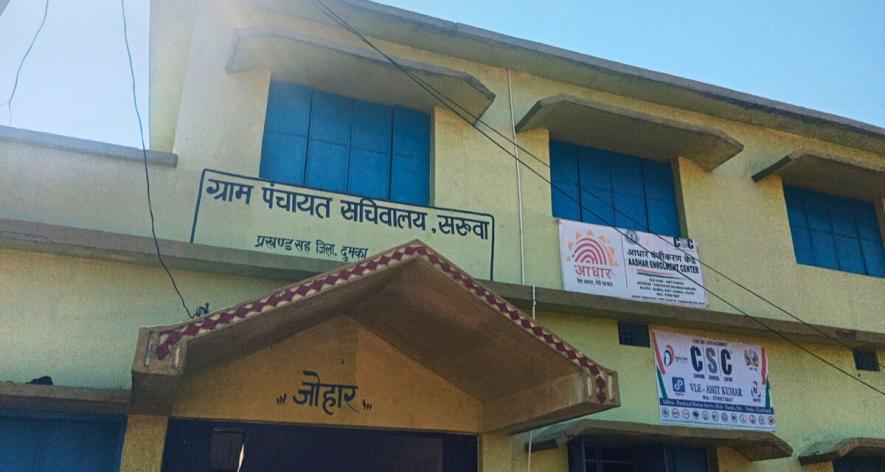
Sarua Panchayat Bhavan (Photo - Rahul Singh, 101Reporters)
Dumka, Jharkhand: The fear of the uncertain is what the tribals of 39 villages around Dumka have been fighting for the last seven years. In July 2017, Jharkhand government issued a notification to include these villages and three census towns in the Dumka Municipal Council.
The notification proposed two plans — Dumka Master Plan Area that includes 39 surrounding villages and census towns of Rasikpur, Dudhani and Purana Dumka with the present Dumka city and the Greater Dumka Planning Area with the inclusion of 93 villages. If the master plan is implemented, Dumka will become a category A city from its present category B. On the other hand, if the Greater Dumka plan is implemented, it will become a municipal corporation.
Soon after the proposal, the villagers launched their protest against the merger. For the next one-and-a-half years, they staged demonstrations from time to time and expressed their opposition in many ways, which eventually stalled the expansion efforts.
However, the tribals still see the stalled proposal as a threat to their tradition, culture and self-governance system. They are very sensitive about the issue and raise their voices against it in every possible way, like during a cultural programme or meeting.
Manjulata Soren (42), the elected representative (mukhiya) of Sarua panchayat, is relieved that the merger has not worked out yet. She hails from Jogidih village, which is just two km from Dumka city. "In 2017, we staged demonstrations in front of the deputy commissioner's office for almost six months. Women were the main participants as men have the responsibility to earn for their families,” said Manjulata.
Bhim Prasad Mandal (60), president, Gram Pradhan Manjhi Sangathan Santal Pargana, an organisation of pradhans of six districts in Santal Pargana region, said that the Santal Pargana Tenancy Act, 1949, restricts the transfer of land belonging to the tribal community.
The Act said that there are two types of land in Santal Pargana, the one that can be bought and sold and the other that cannot be bought or sold. However, even the second type of land is getting transferred to others these days. Residents are wary that other communities will have more access to their land if they become a part of the city.
"If our village joins the city, land transactions will increase. Houses will be built on the land on which tribal families survive by farming. When the demand increases, it could even be transferred to outsiders through gift deeds,” Mantu Marandi (45) of Sarua village told 101Reporters.
Keeping tradition close to heart
Dumka is the divisional headquarters of the Santal Pargana region of Jharkhand. Santal tribals form a majority of the population here. The tribe has its own self-governance system in place, namely manjhi pargana and pradhani shashan.
The head of a Santal tribal village is called manjhi. Being a hereditary system, people from the same family are chosen as heads. Generally, men are the chiefs and in case of their death, their son or wife is elected as chief. Many times, women become leaders when a conflict over occupying the position crops up among the male members of the family or if the son has migrated for work.
Sarua village pradhan (under the tribal self governance system) Sushila Hembram (38) took up that position in 2016, following the death of her husband Sanatan Baski. “For family division of land, we do not go through the legal procedure that non-tribals follow. In our families, we divide the land by holding a meeting in the village itself. It is done peacefully with mutual consent.”
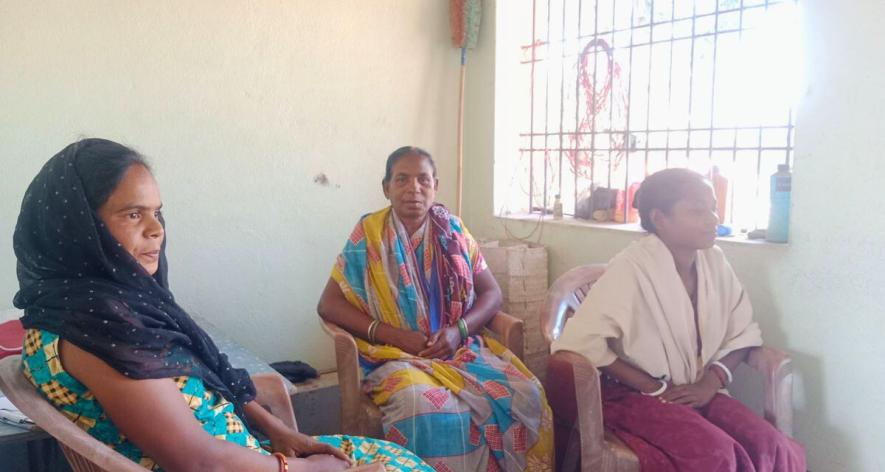
Women of Jogidih village (Photo - Rahul Singh, 101Reporters)
In the meetings chaired by pradhan, land distribution, fights, family disputes and disputes between husbands and wives are resolved. Only in exceptional cases, a complaint reaches the police station or court.
“Even while building a house, we do not have to get the plan approved by the authorities. We do not pay holding tax now. Had we been part of the city, this could have been an additional burden on our village,” Hembram detailed. She added that their religious places marang buru and jaher than and folk festivals Baha and Sohrai will also be affected if their village joined the city.
“If there is a wedding or any function at someone's house, villagers help that family with an interest-free loan. This is a big relief to poor families,” Manjulata said.
“To protect the interest of the tribals and their culture, it is necessary to maintain the traditional self-governance system. For this, it is necessary that the village should be allowed to remain a village,” said Pradeep Kumar Murmu (46), the younger son of Sabina Tudu, the pradhan of Jogidih and Karamdih villages in Sarua panchayat.
Apart from pradhan, there are posts of paranik, nayaki, godet, jaga majhi and kudam nayaki, with different tasks assigned to them. Paraniks are the most powerful officials after pradhan. They act as arbitrators to resolve small disputes and quarrels in the Santal society.
Nayakis are the priests of the Santal tribe, whose job is to conduct pujas and other religious rituals during sacred events at their places of worship. Godet conveys information and informs people to gather at one place for any event. Jaga majhi conducts the wedding rituals, while kudum nayaki conducts the shraddha rituals in case of a sacrifice or the death of someone in the society.
Pradhan gets an honorarium of Rs 2,000 per month from the government, while other officials are given an honorarium of Rs 1,000. These six persons are responsible for the conduct of the village's traditions and other functions.
Since 2008, pradhans have been getting Rs 1,000, which the state government increased to Rs 2,000 from January 1, 2019. Bhim Prasad believes that this is the result of their protest.
“There are about 2,200 village heads and about 8,000 other officials in Dumka district and all of them get paid by the government in their bank accounts. There are 6,987 gram pradhans in six districts of Santal Pargana division. Our efforts are continuing to ensure that self-governance system office-bearers of other five districts also get paid,” said Mandal, who himself is the head of Malbhandaro village in Dumka block.
This traditional governance system extends to non-santals and non-tribals, too. According to Mandal, in the pradhani self-governance system prevalent in Santal Pargana, 70% of the office-bearers are Santal tribals, while other tribal communities of Pahadias and Kols and people from non-tribal and Muslim communities also hold these posts.
Jone Soren, who works as a master trainer of panchayati raj system with government agencies and various voluntary organisations in Dumka, said many laws will become ineffective or less effective if villages are included in the city. Tribal areas have the status of Scheduled Areas and come under the purview of the Panchayat (Extension to Scheduled Areas) Act, 1996, which will end in such a case.
He added that the Santal Pargana Tenancy Act will become less effective as the city expands and the transfer and acquisition of land increases. “Self-governance system is a community-based system. If it ends, the community and identity of the village will be gone. The nature of land will change and the tribal community’s places of worship will also be destroyed,” Jone warned.
Fear of losing welfare schemes
Mary Steela Soren (30) of Jogidih in Sarua panchayat is concerned about the welfare schemes. “We benefit from the Didi Bari scheme, under which we have to set up a vegetable garden on one to five decimals of land. For this, wages of Rs 255 is provided as per the working days under the Mahatma Gandhi National Rural Employment Guarantee Act [MGNREGA] scheme.”
Besides ensuring nutritious vegetables for the family’s use, the excess produce can also be sold in the market. According to Manjulata, about 100 women of her panchayat benefit from the scheme.
The Jharkhand government is working to provide permanent houses to the rural population deprived of the benefits of Pradhan Mantri Awas Yojana. Under the Abua Housing Scheme, Rs 2 lakh is given to build a house of 31 sq m (6.12 m by 5.07 m). “About 40 houses have been approved under the scheme in the panchayat. Their first instalment has been deposited into their accounts,” said panchayat secretary Nasir Mian.
However, as far as MGNREGA is concerned, there is not much demand for work here. "Because of its proximity to the city, people's attraction towards MGNREGA is less here. Only Rs 255 is received as wages per day. The money for material often gets stuck. Work is also not available every day, whereas in the city, people can work for Rs 300 to 350 per day,” Manjulata detailed.
According to the information received from Dumka Municipal Council, there is no ongoing exercise regarding the expansion of Dumka city at the government level. City council sources said that it is true that inclusion of those villages in the city would impose a tax burden on them, but in return, the villagers would get many facilities. Executive Officer of Dumka Municipal Council Shitanshu Xalxo did not comment on the fate of the notification.
Dumka's Welfare Officer Bijan Oraon told 101Reporters that the Welfare Department pays for the fencing of the Santal places of worship. They also contribute for repairs. “It is difficult to construct such sites in urban areas because land will not be easily available,” he agreed.
Rahul Singh is a Jharkhand-based freelance journalist and a member of 101Reporters, a pan-India network of grassroots reporters.
Get the latest reports & analysis with people's perspective on Protests, movements & deep analytical videos, discussions of the current affairs in your Telegram app. Subscribe to NewsClick's Telegram channel & get Real-Time updates on stories, as they get published on our website.










